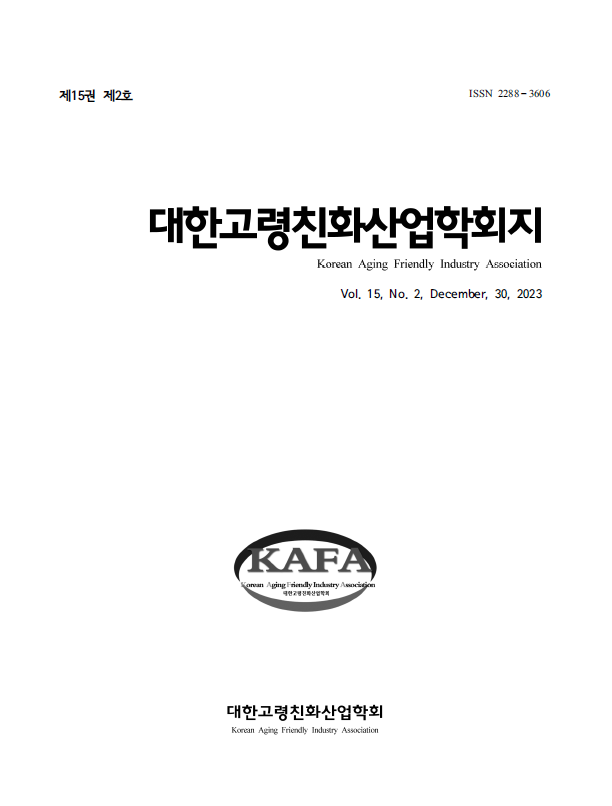보건계열 대학생의 학과 간 연계교육(IPE) 프로그램 적용 효과 연구
Study on the Effect of Health Collage Students' Interprofessional Education (IPE) Program
- 대한고령친화산업학회
- 대한고령친화산업학회지
- 제15권 제2호
-
2023.12157 - 165 (9 pages)
- 350

연구목적 본 연구의 목적은 보건계열 대학생을 대상으로 비정규 교육과정 내 개발⋅운영된 IPE 프로그램에 실험군과 대조군으로 설정하여 비교⋅분석하여 프로그램의 효과를 검증하고자 한다. 이를 통해 정규과정 편성의 필요성과 중요성의 근거 자료로 활용되고자 한다. 연구방법 대상자의 일반적 특성에 대한 두 집단의 동질성 검정은 χ2-test를 이용하여 분석 후 실수와 백분율로 나타내었다. 실험군과 대조군의 효과차이 비교는 평균, 표준편차, t-test로 분석하였다. 연구가설 검증은 t-test로 분석하였다. 자료분석은 SPSS 25.0 프로그램을 이용하였다. 연구결과 본 연구는 보건계열 대학생의 3개 학과 학생들의 IPE 교육에 참여한 실험군과 교육에 참여하지 않은 대조군 비교하여 프로그램의 효과를 검증한 비동등성 사후 실험논문이다. 프로그램 효과검증 결과 전문직 간 팀워크역할과 책임감, 전문가 간 편견은 지지되었고, 환자 중심성, 다양성과 윤리, 지역사회 중심성, 의사소통기술은 기각되었다. 결론 보건계열 3개 학과 학생들이 IPE 중재 프로그램을 개발하고 이를 통해 타 학과의 이론교육과정과 실습교육과정의 이해와 각 학과별 체험의 기회를 제공하였다. 대상자 문제해결을 위한 전문직 간 비판적 사고과정과 의사소통이 필요하다. 향후 보건계열 대학생에게 적합한 전문직 간의 측정도구 개발과 프로그램 개발을 위한 중재연구가 필요하다.
Objective : The purpose of this study is to validate the effectiveness of an Interprofessional Education (IPE) program developed and implemented within an informal educational setting among health science students. This will be achieved by setting up an experimental group and a control group among the students, comparing and analyzing them to assess the program's impact. The aim is to utilize these findings as evidence supporting the necessity and significance of integrating such programs into formal curricula. Methods : The homogeneity of the two groups in terms of the general characteristics of the subjects was assessed using the χ2-test and presented in terms of frequencies and percentages. To compare the differences in effectiveness between the experimental and control groups, means, standard deviations, and t-tests were employed. The validation of research hypotheses was conducted using t-tests. Data analysis was performed using the SPSS 25.0 software. Results : This study is a non-equivalent post-test research paper that validates the effects of an Interprofessional Education (IPE) program by comparing an experimental group, consisting of students from three departments in the health science field who participated in the IPE, with a control group who did not. The results of the program's effectiveness verification supported Teamwork Roles and Responsibilities, Experts Biases. However, Patient-centeredness, Diversity and Ethics, Community-centeredness, and Experts Communication were rejected. Conclusion : Students from three departments in the health science field developed an Interprofessional Education (IPE) intervention program, aiming to provide an understanding of theoretical and practical education courses in other departments and offer experiential opportunities in each department. Critical thinking processes among professionals and communication are necessary for problem-solving among participants. Future research requires the development of suitable measurement tools for interprofessional aspects among health science students and intervention research for program development.
Ⅰ. 서 론
Ⅱ. 연구방법
Ⅲ. 연구결과
Ⅳ. 고 찰
Ⅴ. 결 론
(0)
(0)